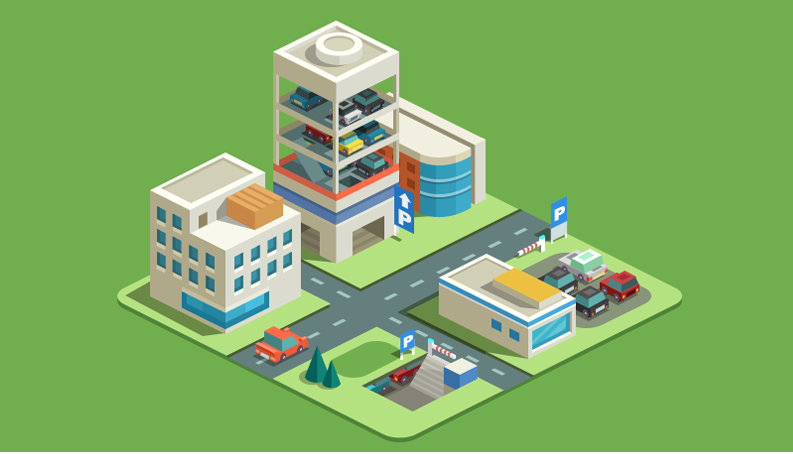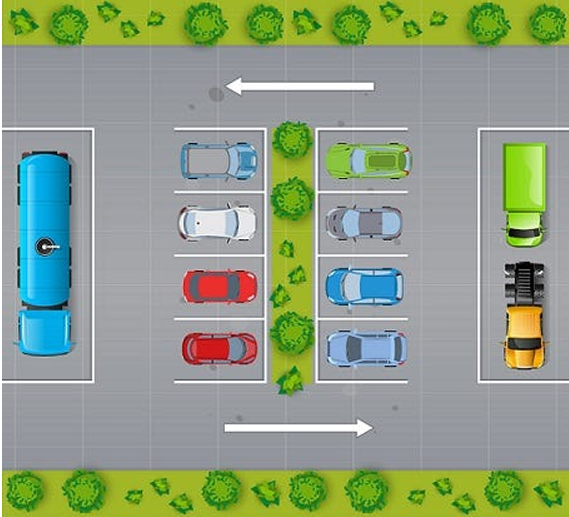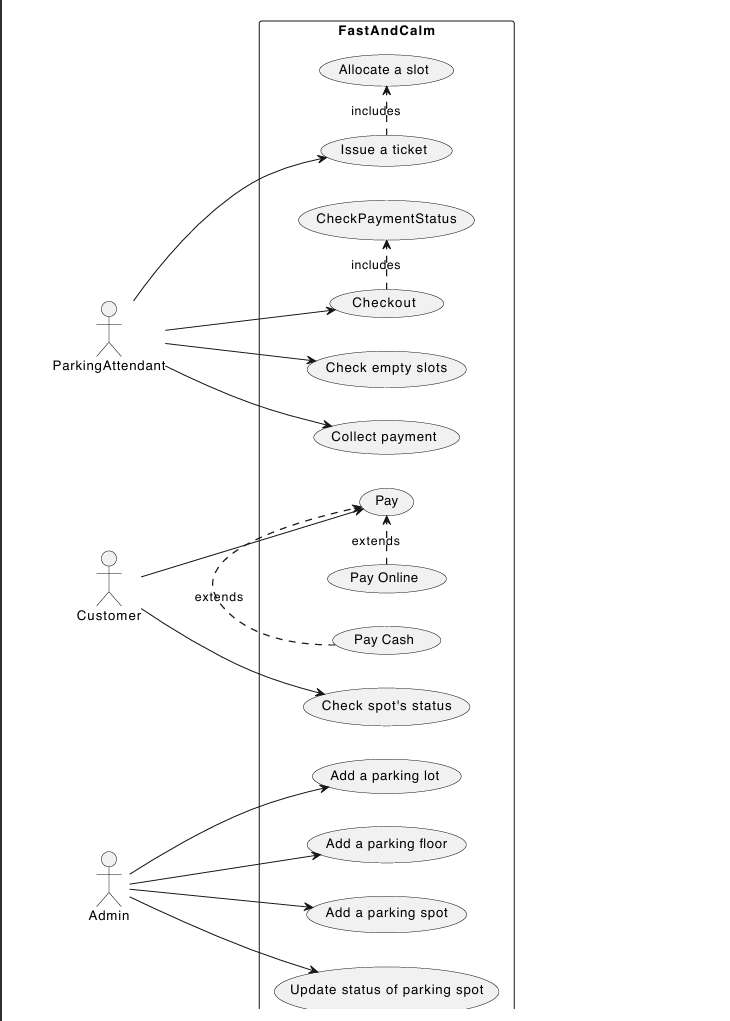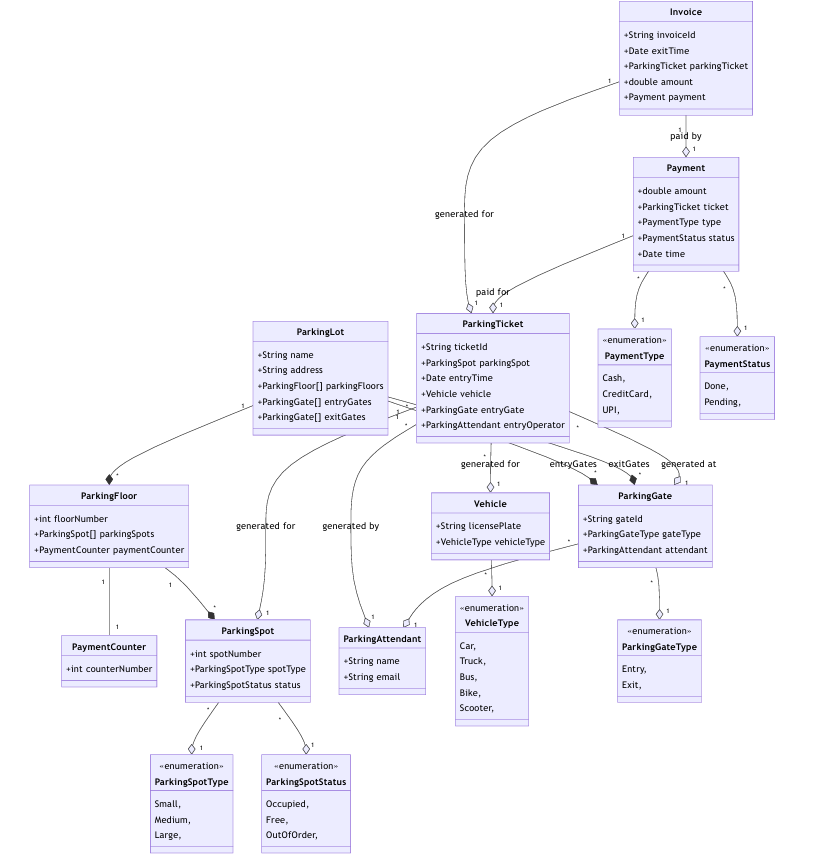Design a parking lot¶
A parking lot or car park is a dedicated cleared area that is intended for parking vehicles. In most countries where cars are a major mode of transportation, parking lots are a feature of every city and suburban area. Shopping malls, sports stadiums, megachurches, and similar venues often feature parking lots over large areas
grokking-the-object-oriented-design-interview/object-oriented-design-case-studies/
at master · tssovi/grokking-the-object-oriented-design-interview · GitHub

Parking lot is an open area designated for parking cars. We will design a parking lot where a certain number of cars can be parked for a certain amount of time. The parking lot can have multiple floors where each floor carries multiple slots. Each slot can have a single vehicle parked in it.
System Design Interview: Parking Lot System | Tech Wrench

Requirements gathering¶
What are some questions you would ask to gather requirements?
- Can a parking lot have multiple floors?
- Can a parking lot have multiple entrances?
- Can a parking lot have multiple exits?
- Can a parking lot have multiple types of vehicles?
- Can we park any type of vehicle in any slot?
- How do we get a ticket?
- How do we know if a slot is empty?
- How are we allocated a slot?
- How do we pay for parking?
- What are the multiple ways to pay for parking?
Requirements¶
What will be 10 requirements of the system, according to you?
Do not worry about the correctness of the requirements, just write down whatever comes to your mind.
Your job is not to generate the requirements, but get better at understanding problem statements and anticipating the functionalities your application might need.
Build an online parking lot management system that can support the following requirements:
- Should have multiple floors.
- Multiple entries and exit points.
- A person has to collect a ticket at entry and pay at or before exit.
- Pay at:
- Exit counter (Cash to the parking attendant)
- Dedicated automated booth on each floor
- Online
- Pay via:
- Cash
- Credit Card
- UPI
- Allow entry for a vehicle if a slot is available for it. Show on the display at entry if a slot is not available.
- Parking Spots of 3 types:
- Large
- Medium
- Small
- A car can only be parked at its slot. Not on any other (even larger).
- A display on each floor with the status of that floor.
- Fees calculated based on per hour price: e.g. 50 rs for the first hour, then 80 rs per extra hour.
- Small - 50, 80
- Medium - 80, 100
- Large - 100, 120
Use case diagrams¶
Are the requirements clear enough to define use cases?
If not, try to think of the actors and their interactions with the system.
Actors¶
What would be the actors in this system?
- Customer
- Parking Attendant, Operator
- Admin
Use cases¶
What would be the use cases i.e. the interactions between the actors and the system?
Actor 1¶
Name of the actor - Admin
Use cases: CRUD
- Create a parking lot
- Create a parking floor
- Add new parking spots
- Update status of a parking spot
Actor 2¶
Name of the actor - Parking attendant
Use cases:
Check empty slots
Issue a ticket - Allocating a slot
Collect payment
Checkout - Has the user paid?
Actor 3¶
Name of the actor - Customer
Use cases:
- Pay - Pay online , Pay at exit gate
- Check status
Add more actors and their use cases as needed.

API design¶
What will be some APIs that you would design for this system?
Look at the use cases and try to design APIs for each of them.
You can simply write the APIs in the following format:
API name - HTTP method - URL - ?Request body - ?Response body
You could also use a tool like Swagger (https://swagger.io/) to design the APIs or follow this (https://github.com/jamescooke/restapidocs) repository for a simple way to use Markdown to structure your API documentation.
Admin APIs¶
All the various use cases are simple CRUD operations. We can design the following APIs for the admin:
Parking lot APIs¶
- createParkingLot - POST /parking-lot - Request body: ParkingLot
- getParkingLot - GET /parking-lot/{id} - Response body: ParkingLot
- getAllParkingLots - GET /parking-lot - Response body: List<ParkingLot>
- updateParkingLot - PUT /parking-lot/{id} - Request body: ParkingLot
- deleteParkingLot - DELETE /parking-lot/{id}
Similarly, we can design APIs for ParkingFloor , ParkingSpot .
Parking spot APIs¶
createParkingSpot - POST /parking-spot - Request body: ParkingSpot
getParkingSpot - GET /parking-spot/{id} - Response body: ParkingSpot
getAllParkingSpots - GET /parking-spot - Response body: List<ParkingSpot>
updateParkingSpot - PUT /parking-spot/{id} - Request body: ParkingSpot
deleteParkingSpot - DELETE /parking-spot/{id}
You might also want an API to Update status of a parking spot . This can be done by using the existing updateParkingSpot API or by creating a new API that only updates the status of the parking spot.
- updateParkingSpotStatus - PUT /parking-spot/{id}/status - Request body: ParkingSpotStatus
- getParkingSpotStatus - GET /parking-spot/{id}/status - Response body: ParkingSpotStatus
Parking attendant APIs¶
Use cases:
- Check empty slots
- Issue a ticket - Allocating a slot
- Collect payment
- Checkout - Has the user paid?
Check empty slots¶
Let us look at the various requirements for a parking spot:
- CRUD on parking spots
- Get all parking spots
- Get all available parking spots
We can augment our current getAllParkingSpots API by adding a query parameter to filter the parking spots based on their status. This will allow us to get all the available parking spots as well.
Get all parking spots¶
- getAllParkingSpots - GET /parking-spot - Response body: List<ParkingSpot>
Get all available parking spots¶
- getAllParkingSpots - GET /parking-spot?status=AVAILABLE - Response body: List
Get all occupied parking spots¶
- getAllParkingSpots - GET /parking-spot?status=OCCUPIED - Response body: List
Issue a ticket¶
- issueTicket - POST /ticket - Request body: TicketRequest - Response body: Ticket
We might not want to use the current Ticket class for the request body since it contains a lot of information that is either not required or is not available at the time of ticket generation. We can create a new class TicketRequest that contains only the required information.

Collect payment¶
- collectPayment - POST /payment - Request body: PaymentRequest Response body: Payment
PaymentRequest:

Checkout¶
checkout - POST /checkout - Request body: CheckoutRequest - Response body: CheckoutResponse
CheckoutRequest:

Class diagram¶
What will be the major classes and their attributes?
- ParkingLot
- Name
- Address
- ParkingFloors
- Entry Gates
- Exit Gates
- ParkingFloor
- Floor Number
- ParkingSpots
- ParkingSpot
- Spot Number
- Spot Type - Large, Medium, Small
- Status - Occupied, Free, Out of order
- ParkingTicket
- Ticket ID
- ParkingSpot
- Entry Time
- Vehicle
- Entry Gate
- Entry Operator
- Invoice
- Invoice ID
- Exit Time
- ParkingTicket
- Amount
- Payment
- Payment Status
- Payment
- Amount
- Ticket
- Type - Cash, Credit Card, UPI
- Status - Done, Pending
- Time
- Vehicle
- License Plate
- Vehicle Type - Car, Truck, Bus, Bike, Scooter
- ParkingAttendant
- Name
List down the cardinalities of the relationships between the classes.
- ParkingLot - ParkingFloor - One to many
- ParkingLot - ParkingGate - entryGates - One to many
- ParkingLot - ParkingGate - exitGates - One to many
- ParkingFloor - ParkingSpot - One to many
- ParkingGate - ParkingAttendant - currentGate - One to one
- ParkingSpot - ParkingTicket - One to many
- ParkingTicket - Invoice - One to one
- ParkingTicket - Vehicle - Many to one
- ParkingTicket - ParkingSpot - Many to one
- Payment - ParkingTicket - One to one
Draw the class diagram.

Look for differences between your class diagram and the one in the solution. List them down below.
1.
2.
3.
4.
